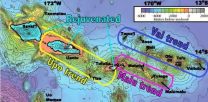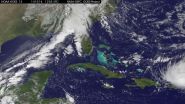(Press-News.org) A UC Santa Barbara geochemist studying Samoan volcanoes has found evidence of the planet's early formation still trapped inside the Earth. Known as hotspots, volcanic island chains such as Samoa can ancient primordial signatures from the early solar system that have somehow survived billions of years.
Matthew Jackson, an associate professor in UCSB's Department of Earth Science, and colleagues utilized high-precision lead and helium isotope measurements to unravel the chemical composition and geometry of the deep mantle plume feeding Samoa's volcanoes. Their findings appear today in the journal Nature.
In most cases, volcanoes are located at the point where two tectonic plates meet, and are created when those plates collide or diverge. Hotspot volcanoes, however, are not located at plate boundaries but rather represent the anomalous melting in the interior of the plates.
Such intraplate volcanoes form above a plume-fed hotspot where the Earth's mantle is melting. The plate moves over time — at approximately the rate human fingernails grow (3 inches a year) — and eventually the volcano moves off the hotspot and becomes extinct. Another volcano forms in its place over the hotspot and the process repeats itself until a string of volcanoes evolves.
"So you end up with this linear trend of age-progressive volcanoes," Jackson said. "On the Pacific plate, the youngest is in the east and as you go to the west, the volcanoes are older and more deeply eroded. Hawaii has two linear trends of volcanoes — most underwater — which are parallel to each other. There's a southern trend and a northern trend."
Because the volcanic composition of parallel Hawaiian trends is fundamentally different, Jackson and his team decided to look for evidence of this in other hotspots. In Samoa, they found three volcanic trends exhibiting three different chemical configurations as well as a fourth group of a late-stage eruption on top of the third trend of volcanoes. These different groups exhibit distinct compositions.
"Our goal was to figure out how we could use this distribution of volcano compositions at the surface to reverse-engineer how these components are distributed inside this upwelling mantle plume at depth," Jackson said.
Each of the four distinct geochemical compositions, or endmembers, that the scientists identified in Samoan lavas contained low Helium-3 (He-3) and Helium-4 (He-4) ratios. The surprising discovery was that they all exhibited evidence for mixing with a fifth, rare primordial component consisting of high levels of He-3 and He-4.
"We have really strong evidence that the bulk of the plume is made of the high Helium-3, -4 component," Jackson said. "That tells us that most of this plume is primordial material and there are other materials hosted inside of this plume with low Helium-3, -4, and these are likely crustal materials sent into the mantle at ancient subduction zones."
The unique isotopic topology revealed by the researchers' analysis showed that the four low-helium endmembers do not mix efficiently with one another. However, each of them mixes with the high He-3 and He-4 component.
"This unique set of mixing relationships requires a specific geometry for the four geochemical flavors within the upwelling plume: They must be hosted within a matrix that is composed of the rare fifth component with high He-3," Jackson explained. "This new constraint on plume structure has important implications for how deep mantle material is entrained in plumes, and it gives us the clearest picture yet for the chemical structure of an upwelling mantle plume."
INFORMATION:
Co-authors of the paper include Stanley R. Hart, Jerzy S. Blusztajn and Mark D. Kurz of the Woods Hole Oceanographic Institution, Jasper G. Konter of the University of Hawaii and Kenneth A. Farley of the California Institute of Technology. This research was funded by the National Science Foundation.
VIDEO:
NOAA's GOES-East satellite captured this image of Hurricane Gonzalo off the U.S. East Coast on Oct. 16 at 13:07 UTC (9:07 a.m. EDT).
Click here for more information.
NASA and NOAA satellites have been providing continuous coverage of Hurricane Gonzalo as it moves toward Bermuda. NASA's Terra satellite saw thunderstorms wrapped tightly around the center with large bands of thunderstorms wrapping into it. NOAA's GOES-East satellite provided and "eye-opening" view of Gonzalo, ...
Tropical Storm Ana continued on a path to the Hawaiian Islands as NASA's Terra satellite passed overhead and gathered data on the storm. NOAA's GOES-West satellite data was compiled into a movie that showed the intensification and movement of Ana. Watches are now in effect for Hawaii.
NOAA's Central Pacific Hurricane Center (CPHC) has issued a Tropical Storm Watch for Hawaii County, Hawaii. A tropical storm watch means that tropical storm conditions are possible within the watch area, in this case within 36 to 48 hours. Life-threatening surf and riptide conditions will ...
An international team of scientists has succeeded in explaining the formation and propagation over astronomical distances of jets of matter emitted by young stars—one of the most fascinating mysteries of modern astronomy. Using a patented experimental device and large-scale numerical simulations, the team obtained data consistent with astrophysical observations. The results of this research—just published in the prestigious journal Science—open up new opportunities for studying the role of magnetic fields in astrophysics and thermonuclear fusion. Bruno ...
Why is the Sun's million-degree corona, or outermost atmosphere, so much hotter than the Sun's surface? This question has baffled astronomers for decades. Today, a team led by Paola Testa of the Harvard-Smithsonian Center for Astrophysics (CfA) is presenting new clues to the mystery of coronal heating using observations from the recently launched Interface Region Imaging Spectrograph (IRIS). The team finds that miniature solar flares called "nanoflares" - and the speedy electrons they produce - might partly be the source of that heat, at least in some of the hottest parts ...
Researchers at the University of Connecticut have found a new way to identify protein mutations in cancer cells. The novel method is being used to develop personalized vaccines to treat patients with ovarian cancer.
"This has the potential to dramatically change how we treat cancer," says Dr. Pramod Srivastava, director of the Carole and Ray Neag Comprehensive Cancer Center at UConn Health and one of the principal investigators on the study. "This research will serve as the basis for the first ever genomics-driven personalized medicine clinical trial in immunotherapy ...
Antibiotic-resistant bacteria can share resources to cause chronic infections, Vanderbilt University investigators have discovered. Like the individual members of a gang who might be relatively harmless alone, they turn deadly when they get together with their "friends."
The findings, reported Oct. 8 in Cell Host & Microbe, shed light on a long-standing question in infectious diseases and may inform new treatment strategies, said Eric Skaar, Ph.D., MPH, Ernest W. Goodpasture Professor of Pathology, Microbiology and Immunology.
One way that Staphylococcus aureus and other ...
Using the NASA/ESA Hubble Space Telescope astronomers have made what may be the most reliable distance measurement yet of an object that existed in the Universe's formative years. The galaxy is one of the faintest, smallest and most distant galaxies ever seen and measuring its distance with this accuracy was possible due only to the incredibly detailed mapping of how giant galaxy clusters warp the space-time around them.
Astronomers often use gravitational lensing -- the magnifying power of galaxy clusters -- to find distant galaxies [1]. However, when it comes to the ...
Boulder, Colo., USA - What is the "Sixth Extinction"? How do paleontologists determine North America's future fire threats? What do trilobites look like on the inside? Did the Chicxulub impact trigger an eruption? Here, the Paleontological Society highlights some of the best science and current work in paleontology to be presented at the 126th Annual Meeting of The Geological Society of America on 19-22 October in Vancouver, BC, Canada.
SUNDAY, 18 Oct.
Geospatial Analysis of Human-Megafaunal Overlap in North America: Lead author Meaghan Emery and colleagues write that ...
Organisms ranging from bacteria to humans have circadian clocks to help them synchronize their biological activities to the time of day. A study published by Cell Press October 16th in Cell now reveals that gut microbes in mice and humans have circadian rhythms that are controlled by the biological clock of the host in which they reside. Disruption of the circadian clock in the host alters the rhythms and composition of the microbial community, leading to obesity and metabolic problems.
"These findings provide an explanation for a long-standing and mysterious observation, ...
Supplementing the diet with omega-6 polyunsaturated fatty acids has beneficial effects on heart health by lowering "bad" LDL cholesterol and raising "good" HDL cholesterol, but the underlying mechanisms involved are poorly understood. Now research based on the genetic information from over 100,000 individuals of European ancestry has uncovered a gene that affects blood cholesterol levels through the generation of a compound from omega-6 polyunsaturated fatty acids, called lipoxins. The study, publishing online October 16 in the Cell Press journal Cell Metabolism, also provides ...




